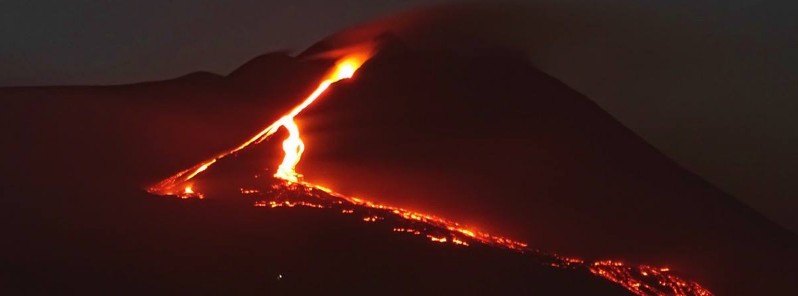Mount Etna’s Southeast Crater is on fire again

The fifth eruptive episode of the year is currently in progress at Italy's Mount Etna. This is the third eruptive episode in less than 10 days.
Etna was calm for about 4 and a half days before the fifth eruptive episode started at 09:34 UTC on April 19, 2017. The source of activity is the Southeast Crater.
"While the previous episode (April 14 and 15) was announced by a sharp increase in the number of earthquakes, followed by a short phase of strombolian activity and then the opening of eruptive fractures, this new episode started with the lava from the Southeast Crater," INGV's Boris Behncke said. "After a few minutes, a moderate strombolian activity began, followed by a sudden increase in the number of earthquakes."
The new lava flow is descending down the western rim of the Valle del Bove.


Video courtesy Fabrizio Zuccarello
Geological summary
Mount Etna, towering above Catania, Sicily's second largest city, has one of the world's longest documented records of historical volcanism, dating back to 1500 BCE. Historical lava flows of basaltic composition cover much of the surface of this massive volcano, whose edifice is the highest and most voluminous in Italy. The Mongibello stratovolcano, truncated by several small calderas, was constructed during the late Pleistocene and Holocene over an older shield volcano. The most prominent morphological feature of Etna is the Valle del Bove, a 5 x 10 km (16 404 x 32 808 feet)horseshoe-shaped caldera open to the east.
Two styles of eruptive activity typically occur at Etna. Persistent explosive eruptions, sometimes with minor lava emissions, take place from one or more of the three prominent summit craters, the Central Crater, NE Crater, and SE Crater (the latter formed in 1978). Flank vents, typically with higher effusion rates, are less frequently active and originate from fissures that open progressively downward from near the summit (usually accompanied by strombolian eruptions at the upper end). Cinder cones are commonly constructed over the vents of lower-flank lava flows. Lava flows extend to the foot of the volcano on all sides and have reached the sea over a broad area on the SE flank. (GVP)
Featured image: Lava flows from Mount Etna on April 19, 2017. Image copyright: Boris Behncke


Commenting rules and guidelines
We value the thoughts and opinions of our readers and welcome healthy discussions on our website. In order to maintain a respectful and positive community, we ask that all commenters follow these rules.